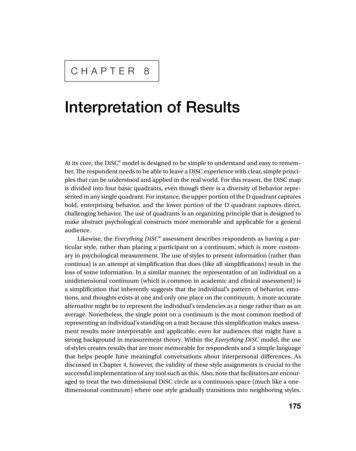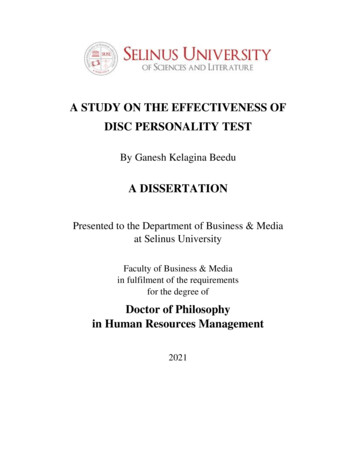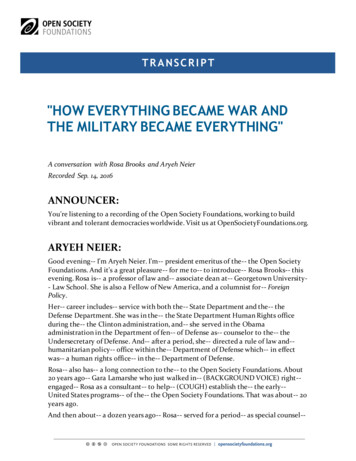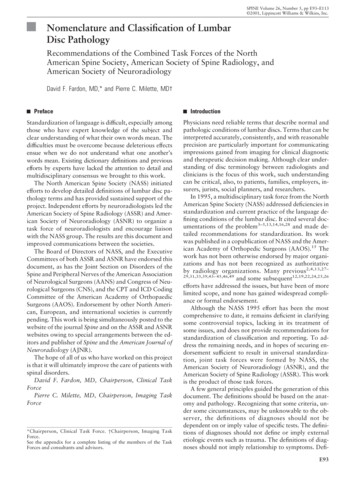
Transcription
Chapter8Interpretation of ResultsAt its core, the DiSC model is designed to be simple to understand and easy to remember. The respondent needs to be able to leave a DiSC experience with clear, simple principles that can be understood and applied in the real world. For this reason, the DiSC mapis divided into four basic quadrants, even though there is a diversity of behavior represented in any single quadrant. For instance, the upper portion of the D quadrant capturesbold, enterprising behavior, and the lower portion of the D quadrant captures direct,challenging behavior. The use of quadrants is an organizing principle that is designed tomake abstract psychological constructs more memorable and applicable for a generalaudience.Likewise, the Everything DiSC assessment describes respondents as having a particular style, rather than placing a participant on a continuum, which is more customary in psychological measurement. The use of styles to present information (rather thancontinua) is an attempt at simplification that does (like all simplifications) result in theloss of some information. In a similar manner, the representation of an individual on aunidimensional continuum (which is common in academic and clinical assessment) isa simplification that inherently suggests that the individual’s pattern of behavior, emotions, and thoughts exists at one and only one place on the continuum. A more accuratealternative might be to represent the individual’s tendencies as a range rather than as anaverage. Nonetheless, the single point on a continuum is the most common method ofrepresenting an individual’s standing on a trait because this simplification makes assessment results more interpretable and applicable, even for audiences that might have astrong background in measurement theory. Within the Everything DiSC model, the useof styles creates results that are more memorable for respondents and a simple languagethat helps people have meaningful conversations about interpersonal differences. Asdiscussed in Chapter 4, however, the validity of these style assignments is crucial to thesuccessful implementation of any tool such as this. Also, note that facilitators are encouraged to treat the two-dimensional DiSC circle as a continuous space (much like a onedimensional continuum) where one style gradually transitions into neighboring styles.175c08.indd 1753/24/2015 11:02:52 AM
176Everything DiSC ManualInterpretations that describe the styles as fixed or rigid should be avoided. The shading oneach respondent’s Everything DiSC map is designed to reinforce the continuous nature ofthe model and of human nature.Interpretation of StyleDot placement conveys two pieces of information: (1) DiSC style and (2) style inclination.To start, the angle of the dot within the circle determines the assignment of style. As canbe seen in Figure 8.1, the Everything DiSC map can be broken into 12 equally spaced segments, each corresponding to a set of angles. The iD style, for example, is representedby 0 to 30 degrees on the DiSC map. A person whose dot is located at the 45-degree anglewould be assigned an i style. A person whose dot is located at the 338-degree angle wouldbe assigned a Di style.Each person who takes the Everything DiSC assessment is plotted on the EverythingDiSC map with a dot. The example in Figure 8.2 shows a person (represented by the dot)who tends toward the D region, but also somewhat toward the i region. This representsa Di style. This person, therefore, is probably particularly active, bold, outspoken, andpersuasive, as these qualities generally describe people who share both the D and istyles.Figure 8.1 The Everything DiSC Map by Anglec08.indd 1763/24/2015 11:02:52 AM
Interpretation of Results177Figure 8.2 Everything DiSC Map with Plotted DotInterpretation of InclinationThe distance of the dot from the center of the circle is also meaningful. People whose dotsfall toward the edge of the circle are said to be much more “inclined” toward their DiSCstyles. On average, the characteristics (e.g., active, bold, outspoken, persuasive) associated with their style (e.g., Di) will be much more pronounced for them than they are forsomeone whose dot is closer to the center of the circle. By way of comparison, imagine acontinuum that ranges from extrovert (on the left) to introvert (on the right). We can havetwo introverted people that are located on the right side of the continuum, but one (whois more introverted) will be placed further to the right than the other person (who is lessintroverted). One person will be expected to show more pronounced introverted traitsthan the other. In the context of DiSC, then, using our Di example, the person whose dotis close to the edge of the circle has a more pronounced Di style than someone whosedot is close to the center of the circle. The person whose dot is close to the center of thecircle will be more likely to demonstrate characteristics (e.g., being cautious, deferring) ofthe style that is on the opposite side of the circle from his or her dot (SC in this example),although these opposite-side characteristics are not expected to be pronounced in eitherindividual.c08.indd 1773/24/2015 11:02:52 AM
178Everything DiSC ManualInterpretation of ShadingEach Everything DiSC map includes shading that surrounds the respondent’s dot. Thisshading provides a rough approximation of the individual’s comfort zone—behaviorsand attitudes that will come naturally to the person and require little conscious effort.Figure 8.3 shows a person with a CD style. As with all maps, the shading includes thethree priorities closest to his dot: accuracy, challenge, and results. These three prioritiesquickly explain some core behaviors associated with the CD style (e.g., speaking up aboutproblems even when they are sensitive, insisting on efficiency even when it will upset thestatus quo).The shading also communicates which regions of the map might require extraeffort for the person. For instance, this person’s shading does not come very close tothe support priority, suggesting that listening empathetically may not be a naturalstrength for him or might make him uncomfortable. Likewise, the shading does notcome very close to the enthusiasm priority, suggesting that outward displays of joy orexcitement are probably infrequent. Not all people with the CD style, of course, are thesame. For that reason, the Everything DiSC assessment measures every priority andwill include extra shading for an individual if his or her score on the priority is overa pre-set threshold. This threshold was designed such that approximately one-thirdFigure 8.3 Example of Shading on an Everything DiSC Mapc08.indd 1783/24/2015 11:02:52 AM
Interpretation of Results179of respondents would receive an extra priority in their report. An example of extra shading is included in Figure 8.4 in the following section. As well, shading does reflectthe respondent’s i nclination. Respondents with dots closer to the center will find thattheir shading is larger and more oblong than the shading illustrated in Figure 8.3. Insuch a case, the individual’s dot is closer to priorities on the opposite side of the map,and, consequently, the individual would likely be more comfortable adopting thosebehaviors when they are needed. As mentioned earlier, however, the Everything DiSCshading is only designed to be a rough approximation of an individual’s comfort levelwith different regions of the map.Case StudiesThe hypothetical case studies presented in this section are designed to (1) illustrate therelationship between profile results and real-life behavior and (2) model the appropriate interpretation of profile results. Note that these cases include specific characteristicsthat should not necessarily be generalized to every person sharing a particular style. Inone of the cases, for instance, Andrea, who has a D style, is defensive and arrogant aboutreceiving feedback. This should not be taken to mean that every person with a D styleis defensive and arrogant in response to receiving feedback. This is simply one possiblemanifestation of that DiSC style.The case studies presented here include the individual’s Everything DiSC map, butalso an umbrella graph. The umbrella graph shows the person’s scores on the eight DiSCscales and can give a practitioner additional insight into the respondent’s DiSC style. Onthis graph, scale scores are plotted such that higher scale scores are closer to the edge ofthe circle. Scale scores that are average are plotted at the halfway mark on each radius.These umbrella graphs are not included in the respondent’s Everything DiSC Profile, butare available in the Everything DiSC Supplement for Facilitators.Andrea: D StyleAndrea is a 31-year-old medical device salesperson. Over the past eight quarters, she hasconsistently been among the top five salespeople in her division. She is seemingly fearless when it comes to initiating contact with potential clients and pushing for their business, even in the face of repeated rejection. She particularly enjoys the part of her job thatinvolves charming and persuading others. Some clients, however, have reported that herapproach feels manipulative and insincere, and have asked to switch to other representatives from her company. The leadership at her organization has shown concern thather aggressive tactics may be hurting the company’s brand in its tight-knit industry. Herresponse to this feedback has been perceived as defensive and, to some degree, cocky.c08.indd 1793/24/2015 11:02:52 AM
180Everything DiSC ManualUltimately, however, her history of results has allowed her to get away with some behaviors that might not be tolerated in others.The assessment suggests that Andrea has a D style with an extra priority in Enthusiasmand a strong inclination toward her style (see Figure 8.4). Further, the umbrella graphindicates that her pattern of scores on the DiSC scales is as expected for someone withher dot placement and shading (see Figure 8.5). That is, she scored high on the D, CD, Di,and i scales and low on the S, CS, and C scales. This profile is associated with people whoare bold, forceful, and enterprising. Her level of drive is typical for people with this styleand, given her current level of immaturity, much of her self-worth may be wrapped up inher ability to achieve results. At her current stage of development, she has an exaggeratedsense of her own rights, particularly relative to the rights of others. Likewise, she oftenonly shows interest in the emotional experience of other people to the degree that it willhelp her achieve her goals.The aspects of her behavior and personality that are entrepreneurial and charismaticare reflected in the extra priority of Enthusiasm. The D style is typically associated withmore forceful persuasion tactics, whereas Andrea’s atypical results suggest that she is alsoaccustomed to smooth talking and charming others. Her approach is still heavy-handed,though, and consequently she can come across as manipulative in her relationships.It is important to note that Andrea represents an immature example of the D style.Her arrogance and insensitivity is characteristic of people with the D style who also havea low level of ego integration and self-realization. The Everything DiSC assessment, however, does not measure psychological maturity or emotional intelligence. This is to say,by simply looking at her dot placement and shading, we would not know how healthyor adaptive Andrea’s unique manifestation of the D style is. We would, however, expectFigure 8.4 Andrea’s DiSC Mapc08.indd 180Figure 8.5 Andrea’s Umbrella Graph3/24/2015 11:02:52 AM
Interpretation of Results181to see a predictable pattern of priorities, tendencies, and preferences (e.g., forcefulness,directness).Rafael: CS StyleRafael is a 54-year-old claims adjuster. He has worked at the same company for the past9 years and in the same position for the last 6 years. He consistently receives positivereviews on his performance evaluations, and he is regarded as professional and competent by both clients and colleagues. His coworkers see him as the “go-to guy” for answerswhen they get stuck, and his manager enjoys the fact that she has to spend very littletime supervising him. Despite his clear expertise and follow-through, however, Rafael hasbeen passed up for promotion three times; twice these promotions went to colleagueswith less seniority and skill than him. In addition, some coworkers feel that he can beunrealistically rigid about procedures. Although he doesn’t force these views on others,they can slow down his team’s progress.The assessment indicates that Rafael has a CS style, with a strong inclination (seeFigure 8.6). Further, his umbrella graph indicates that his pattern of DiSC scale scores isconsistent with a strong CS style (see Figure 8.7). That is, he received very high scores onthe C, CS, and S scales, moderate scores on the iS and CD scales, and very low scores on theD, Di, and i scales. This profile is associated with someone who is modest, self-controlled,and systematic. Like others with this style, Rafael places a particularly strong priority onstability and accuracy. He takes steps to create a predictable environment for himself andmay be overly wedded to systems and routines that provide comfort for him. He has aFigure 8.6 Rafael’s DiSC Mapc08.indd 181Figure 8.7 Rafael’s Umbrella Graph3/24/2015 11:02:52 AM
182Everything DiSC Manualstrong task orientation but is not challenging or argumentative with his colleagues whenhe disagrees with them. This is largely reflected by his middling placement on the horizontal dimension of the Everything DiSC map (skeptical to accepting), but also by his lowerplacement on the vertical pace dimension (moderate-paced to fast-paced).Also consistent with his lower placement on the pace dimension is a relatively passive disposition. He is not highly assertive and does not feel comfortable self-promoting.Likewise, he comes across as soft-spoken and avoids the limelight. As a result, his contributions can be overlooked, and he may not come to mind when the organization’s leadership is trying to identify its high-potential employees.Amira: i StyleAmira is a 28-year-old nurse practitioner. She’s just started her first job out of school ata large metropolitan hospital and has already made strong connections with most ofthe people inside her department. Her coworkers find her to be cheerful, warm, and thorough. Her favorite parts of the job are meeting new people, providing support forthem, and giving them the medical information that can help relieve their anxiety.Her least favorite part of the job is dealing with a small subset of her coworkers whoare cynical, condescending, and sometimes sloppy in their work with patients. Their behavior is deeply unsettling for her, but she does her best to gloss over her objectionsand remain positive.Amira’s results suggest that she has an i style, with an additional priority on accuracy(see Figure 8.8). In most instances, extra priorities are adjacent to the solid shading withinthe Everything DiSC map. As such, Amira’s profile is uncommon, and the conflicting priorities are conceptually more difficult to reconcile compared to a more traditional profile.One theme common among people with this pattern of results is a desire to present apolished appearance. This manifests itself on both a task and interpersonal level. Withregard to her work, Amira is attentive to deadlines and ensures that her output is beyondreproach. With regard to relationships, she wants to come across as poised and affable.Amira has a moderate inclination toward her style. Although she has a clear preference for the i style, the more pronounced characteristics often associated with the istyle (e.g., striking up conversations with strangers, being the life of the party) are lesslikely to be true for her. For instance, although Amira is sociable and has quickly formedrelationships with many in her department, she has not necessarily branched out of herdepartment to befriend people with whom she has less frequent contact. The umbrellagraph indicates a moderately high score on the C scale (see Figure 8.9), but because shereceived an extra priority in Accuracy, it is reasonable to assume that she scored high onthe Accuracy priority scale in the Workplace assessment. The umbrella graph also showsrelatively low scores on the D and CD DiSC scales, which may explain why she prefers toc08.indd 1823/24/2015 11:02:52 AM
Interpretation of ResultsFigure 8.8 Amira’s DiSC Map183Figure 8.9 Amira’s Umbrella Graphavoid a potentially contentious confrontation with her coworkers, despite being deeplytroubled by their behaviors.James: S StyleJames is a 41-year-old manager in a customer service department. For the past 3 years, hehas overseen a team of eight employees, before which he was a customer service representative for 12 years. He is highly regarded among his direct reports for his support andflexibility. Further, they respect his wealth of knowledge about the organization’s products and processes. Several of his direct reports, however, have expressed frustration at hisunwillingness to confront team members that are not pulling their weight. Two employees in particular have stopped answering calls when they are busy and this increases theworkload on everyone else. The brunt of the extra work, however, has been picked up byJames himself. The director of the department is pleased with the consistency of James’team but notes that he has done little to innovate or advance the group’s productivity,even when given a company mandate to do so.The assessment indicates that James has a fairly typical S style, with a strong inclination (see Figure 8.10). The umbrella graph shows moderate scores on the C and CDscales and low scores on the D, Di, and i scales (see Figure 8.11). James’ discomfort withinterpersonal tension is reflected in his low CD and D scores, and his discomfort withassertiveness is reflected in his low D and Di scores.James’ willingness to put his own needs aside for the sake of others or for the sakeof preserving harmony is typical of the S style. He prefers a calm, peaceful environmentc08.indd 1833/24/2015 11:02:52 AM
184Everything DiSC ManualFigure 8.10 James’ DiSC MapFigure 8.11 James’ Umbrella Graphwhere everyone gets along. Consistent with this preference, he has little drive to initiatelarge-scale change in his department or take chances on untested processes. Likewise, heis very reluctant to push his direct reports to work harder or move outside their comfortzones. As a result, the culture on his team is pleasant and low key, but not particularlyresults-oriented.c08.indd 1843/24/2015 11:02:52 AM
176 eryting DiSC anual Interpretations that describe the styles as fixed or rigid should be avoided. The shading on each respondent's Everything DiSC map is designed to reinforce the continuous nature of the model and of human nature. Interpretation of Style Dot placement conveys two pieces of information: (1) DiSC style and (2) style .










